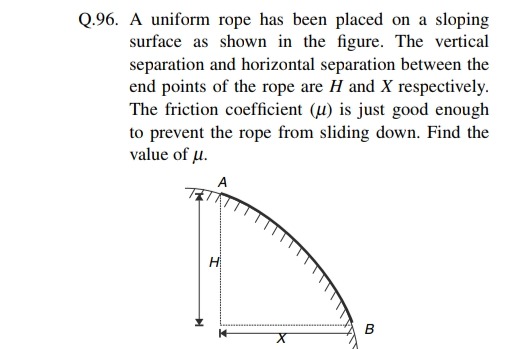Question
Question: A uniform rope has been placed on a sloping surface as shown in the figure. The vertical separation ...
A uniform rope has been placed on a sloping surface as shown in the figure. The vertical separation and horizontal separation between the end points of the rope are H and X respectively. The friction coefficient (μ) is just good enough to prevent the rope from sliding down. Find the value of μ.

X/H
H/X
H*X
H+X
X/H
Solution
Let W be the weight of the rope, acting vertically downwards. Let Nres be the resultant normal force exerted by the surface on the rope, acting perpendicular to the surface. Let Ff be the resultant friction force exerted by the surface on the rope, acting parallel to the surface, opposing the downward motion.
Since the rope is just prevented from sliding down, it is in equilibrium. This means the net force acting on the rope is zero. The weight W acts vertically downwards. The resultant of the normal force Nres and the friction force Ff must balance the weight W. Therefore, the resultant force R=Nres+Ff must be acting vertically upwards.
The friction force Ff is parallel to the surface, and the normal force Nres is perpendicular to the surface. The resultant R is the vector sum of Nres and Ff. The angle between Nres and Ff is 90∘.
Let θ be the angle the sloping surface makes with the horizontal. The normal force Nres is perpendicular to the surface, so it makes an angle of 90∘−θ with the horizontal. The friction force Ff is parallel to the surface, so it makes an angle of θ with the horizontal.
The resultant force R is vertical. Consider the angle between the resultant force R and the normal force Nres. This angle is 90∘−θ. In the vector triangle formed by Nres, Ff, and R, we have: tan(angle between Nres and R)=NresFf
Since the rope is on the verge of sliding, the static friction force is at its maximum value, Ff=μNres. Therefore, tan(angle between Nres and R)=μ.
We know that the angle between Nres and R is 90∘−θ. So, tan(90∘−θ)=μ. This implies cotθ=μ.
Now, we need to determine the effective angle θ of the slope from the given geometry. The vertical separation between the endpoints is H, and the horizontal separation is X. This implies that the tangent of the effective angle of the slope is given by the ratio of the vertical separation to the horizontal separation. tanθ=XH
Substituting this into the equation for μ: μ=cotθ=tanθ1=H/X1=HX
Thus, the value of the friction coefficient is X/H.
